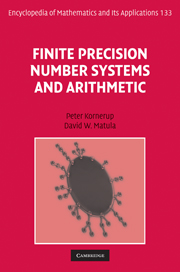2 - Base and digit set conversion
Published online by Cambridge University Press: 05 March 2013
Summary
Introduction
Conversion of a number from one radix representation into another plays an important role in computing, the most obvious example being the conversion between the binary representation and the everyday decimal representation that occurs in most I/O operations. But, as we shall see later, many arithmetic algorithms depend heavily on the ability to convert between radix systems, because some algorithms may be faster if performed in higher radices, and in particular if redundant digit sets are exploited.
There is amazingly little published in the open literature on these subjects in their own right; most of what can be found is usually either very trivial, or embedded in the description of some particular application.
There are, however, many such results, e.g., in multioperand addition or in multiplication the accumulation of many summands is often performed in a redundant representation, and only at the end converted into a non-redundant representation. This final digit set conversion is traditionally described as an addition process, but one may also consider ordinary addition a special case of digit set conversion.
The characteristic idea in many algorithms for multiplication often lies in converting one of the factors into a redundant representation in a higher radix, but may not really be described as such, rather it is seen as some kind of trick. Similarly, in digit serial division algorithms the quotient may be delivered in a redundant representation, but has to be converted before it is delivered as the result.
- Type
- Chapter
- Information
- Finite Precision Number Systems and Arithmetic , pp. 59 - 118Publisher: Cambridge University PressPrint publication year: 2010

